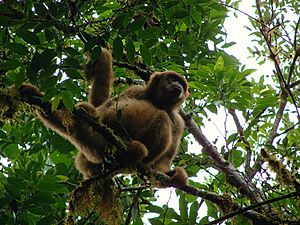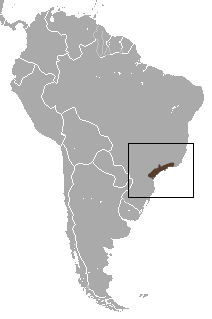Southern muriqui facts for kids
Quick facts for kids Southern muriqui |
|
|---|---|
 |
|
| Conservation status | |
| Scientific classification | |
| Genus: |
Brachyteles
|
| Species: |
arachnoides
|
 |
|
| Southern muriqui range | |
The southern muriqui (Brachyteles arachnoides) is a special type of muriqui (also called a woolly spider monkey). These monkeys live only in Brazil, a country in South America.
Contents
Where Southern Muriquis Live
Southern muriquis live in specific parts of the Atlantic Forest, a large rainforest in Brazil. You can find them in the Brazilian states of Paraná, São Paulo, Rio de Janeiro, Espírito Santo, and Minas Gerais. Local people sometimes call this New World monkey mono carvoeiro, which means "charcoal monkey."
What Southern Muriquis Look Like
Muriquis are the biggest New World monkeys and the largest native monkeys in the Americas.
Male muriquis are about 55–78 cm (21.5–30.5 in) long from head to body. Their tails are very long, about 74–80 cm (29–31.5 in). They can weigh between 9.6–15 kg (21–33 lb). Female muriquis are a bit smaller. Their head and body are about 46–63 cm (18–25 in) long, with tails around 65–74 cm (25.5–29 in). Females usually weigh between 8–11 kg (18–24 lb).
Both male and female muriquis have tails that can grab things, like tree branches. This is called a prehensile tail. The southern muriqui has a solid black face. This helps tell it apart from the northern muriqui, which has a black face with pink spots.
What Southern Muriquis Eat
Southern muriquis mostly eat fruit. This means they are frugivores. They are known to eat many different kinds of fruit found in the Atlantic Forest. They also eat leaves, flowers, and some seeds. Some of the seeds they eat come from trees like sapucaia, Inga, Bicuiba, and jatobá.
Muriquis are very important for spreading seeds. When they eat fruit and then move around, they help new trees grow. They also create food opportunities for other animals, like tapirs.
Southern Muriqui Behavior
Male southern muriquis usually stay in the group where they were born. Female muriquis, however, often move to new groups. This helps keep the monkey population healthy by mixing up their genes.
These monkeys are known for being very friendly with each other within their own group. They are sometimes called "hippie monkeys" because they are so relaxed. However, they can be less friendly towards muriquis from other groups.
Protecting Southern Muriquis
The southern muriqui is an endangered species. This means there are not many of them left in the wild. Their numbers have dropped because of habitat destruction (their homes being destroyed) and hunting.
Today, there are only two groups of southern muriquis living in zoos. One group is in the Curitiba zoo, and the other is in the Sorocaba zoo in Brazil. The wild population was estimated to be about 1,300 monkeys in 2005.
Muriquis are considered a flagship species. This means they are a very important animal that helps bring attention to protecting the entire Atlantic Forest. In 2005, many experts worked together to create plans to save muriquis from extinction. The Brazilian government officially recognized a plan to protect muriquis in 2010.


